3 Tricks For Easily Jumping Between Projects
In case you're a free-flowing project-hopper like me
Pre-order Campaign!
First things first, before I get to the meat of this newsletter: the Witchlight pre-order campaign has kicked off! 🎉
So, if you want to join the fun and get access to the goodies, then make sure you’ve pre-ordered Witchlight—and English-language edition will do—and submitted your receipt.
Also, international orders qualify! Pre-order links are at the buttons below.
3 Tricks For Easily Jumping Between Projects
On tour for The Executioners Three a few weeks ago, one of the most common questions I got was some variation of:
Since you work on so many books at once, how do you keep them all separated in your head?
I love this question! Although, that said, my first instinct was to rebel against it. Oh, I don’t have any problem with that! It’s just natural.
However, as with many things in my writing process, once I actually sat down and considered it, I could tease out some tricks I rely on to keep so many distinctive stories and characters separated in my brain.
1. Change the Font
This is by far the most important trick. Like, I can’t overstate how much I rely on this hack—and how much I cannot read one of my own books in Times New Roman ever again.
The standard font in publishing, when you turn it in to your editor/agent/pal, is 12pt Times New Roman (usually double spaced). For years, that was all I used.
Now I hate it.
And other than the font size and the spacing (I still use 12pt, but I set spacing to 1.5) nothing is ever the same between my books. Instead, I select a font that best fits the overall vibe of what I’m writing.
I’ll give you some examples. Below, I’ve got the opening chapter of Witchlight and another epic fantasy I’ve been chipping away at for a few years called The Alchemist and the Nightsong.
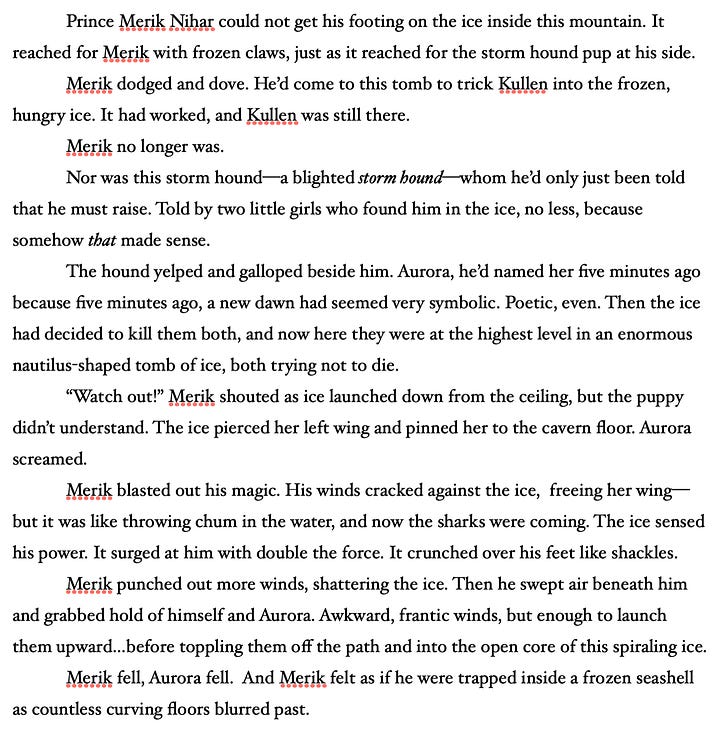
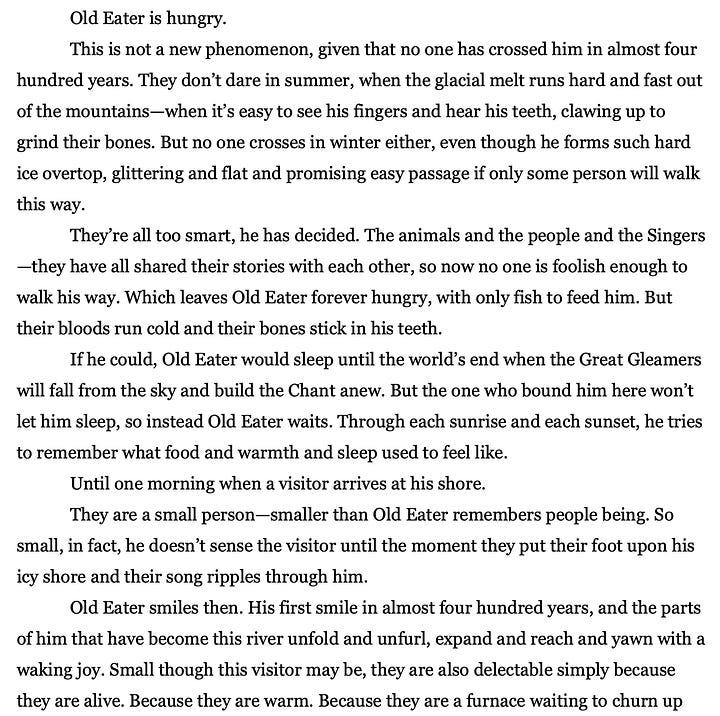
As you can see, I’ve chosen serif fonts for these books because a serif font just fits the vibe of “epic fantasy” in my mind. Witchlight is in Hoefler Text; Alchemist is in Georgia.
As you can guess, the characters in these books are completely different—not to mention the worlds and magics are nothing alike. Also, oh yeah! The tenses! I’ve got third past for Witghlight and third present for Alchemist.
But when I open up the documents? It only takes me a few sentences to slide right into one voice or the other.
Okay, but what about books that are even more different? Like, not just two epic fantasies with tense changes?
Well, here are two projects. You’ll see that I again picked serif fonts—but note how different the voices are. Also, the genres.
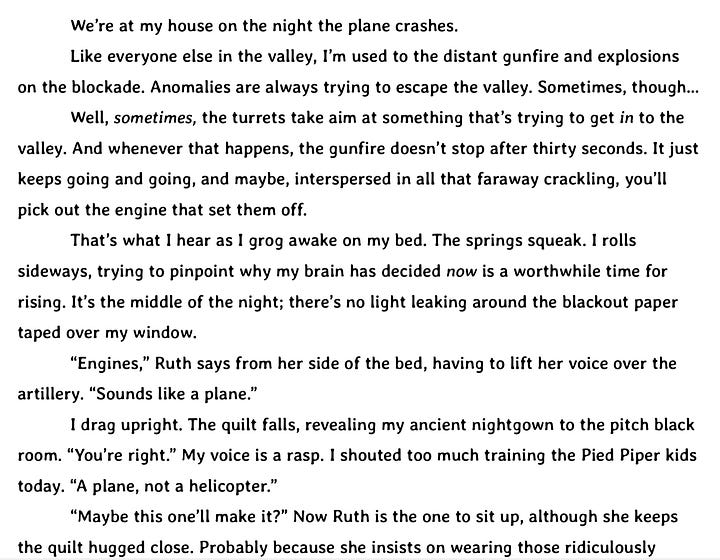
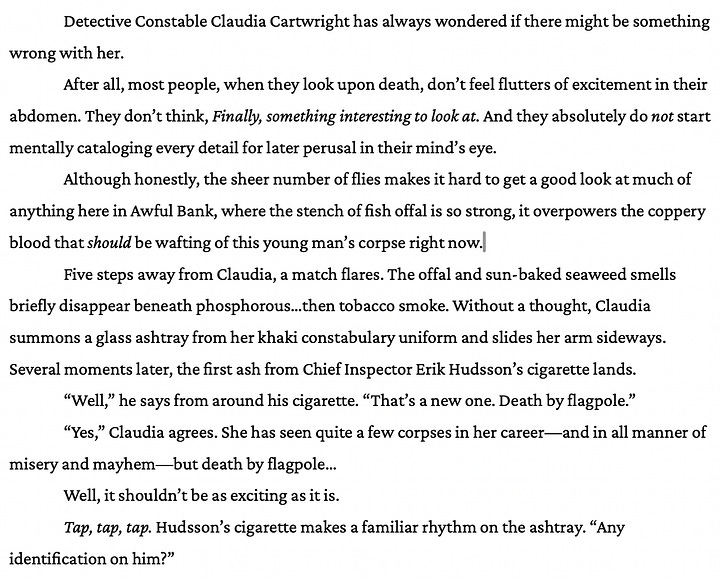
You’ll also likely have spotted that I’ve got first person present tense in one project and third person present in the other. The one titled Sector 26 is a WWII vibes post-apocalyptic with monsters. The other (titled The Hand That Feeds) is a 1920s vibe detective story set in a fantasy city where gods are at war.
(The fonts, by the way, are Averia Libre1 and Crimson Pro.)
Last example, for something more “modern.” These are two screenshots from my upcoming Murder Quartet series. Although each book in that series is a romantic mystery horror set in an alternate 90s with ghosts and murder, each book also stands alone.
Different heroine, different mystery, different setting and romance each time. So, yet again, I must have different fonts for every book.
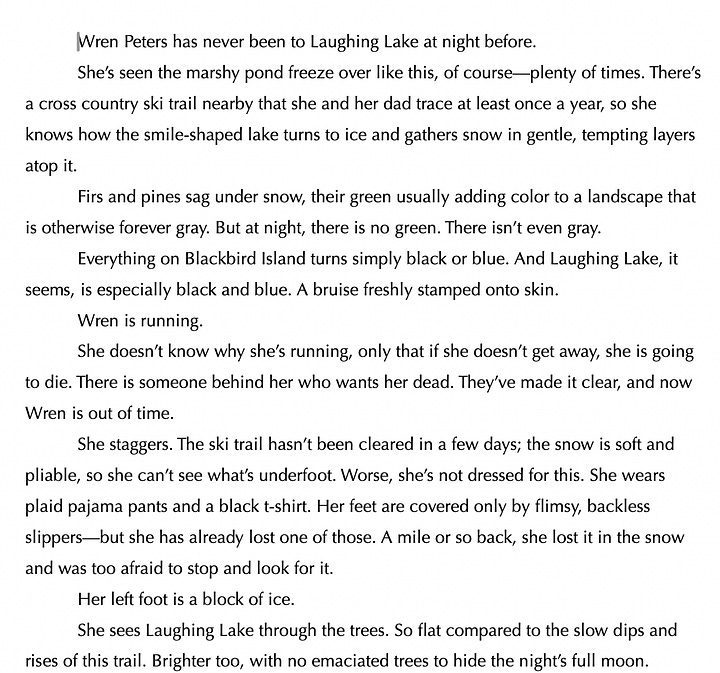
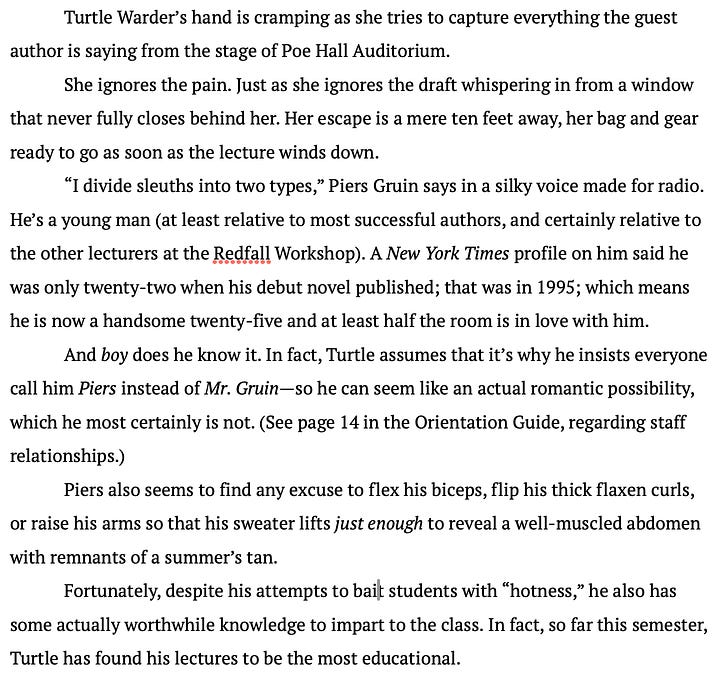
For the second Murder Quartet book (Four & Twenty Blackbirds), which is set on a tiny, blustery island in the middle of winter, I wanted something that felt edgy. Wren is dealing with a haunted Cold War era airfield and horrifying visions—and it’s very Twin Peaks meets Stranger Things. So I wound up with Optima as the font.
For the fourth Murder Quartet book (One Raven for a Dove), set at a remote, forested campus for a writer’s workshop (during fall), I wanted something that reflected my heroine—an aspiring mystery writer. She loves writing about sleuths and reading about sleuths, so I wanted a font that captured the feel of the paperbacks she’s always devouring. That font, in turn, is PT Serif.
As I’m sure you can guess, I have so many more books I could share here. Some short stories too, all of which I am either working on currently or have finished this year.
I am not exaggerating when I say “I jump projects a lot.” Between Friday and Monday alone, I worked on three different books.
And no, I had zero problem just jumping from one voice + world to another.2
2. Change the Playlist
This is a more obvious suggestion, since I feel like most writers make playlists for their books. I’m no different.
I’ve got a Witchlight playlist, filled with a lot of Two Steps from Hell and 2WEI.
I have an Alchemist playlist, which is mostly just the soundtracks from Baldurs Gate 3 and Divinity: Original Sin 2 because I love Borislav Slavov. (This one and this one just gut me.)3
For the Murder Quartet, I have a weird playlist filled with present day hits like this, 80s classics like this, and 90s stuff I once loved like this.
I just pop on these assorted playlists, and bam! Vibes reclaimed.
I especially like listening to my playlists when I’m out for my runs. Because I tend to write a lot of action, I will literally (this is embarrassing to admit) pretend I’m my character running from a monster or blasting out magic or swinging a sword through battle.4
3. Refer to the Color-Coded Moodboard
Moodboards are also popular for writers to make, and I’m no different in this regard. (I talked about making moodboards here.)
However, one thing I do for my moodboards is give them a unified color scheme. This helps me really lock into the vibes—and I will tweak and adjust the colors a bajillion times until the moodboard is just right and accurately reflects what I feel inside my brain.
Here are some examples, and I think you can see with a glance just how different each of these books must feel.
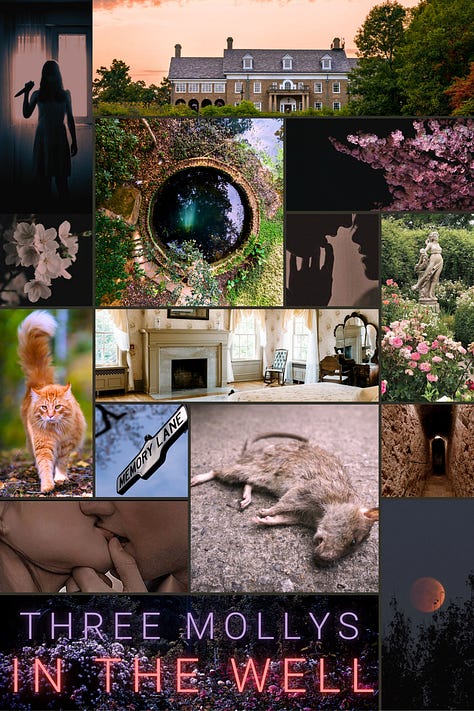
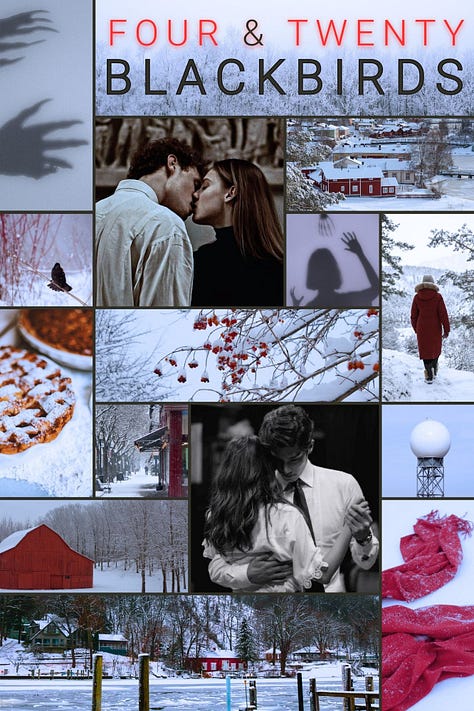
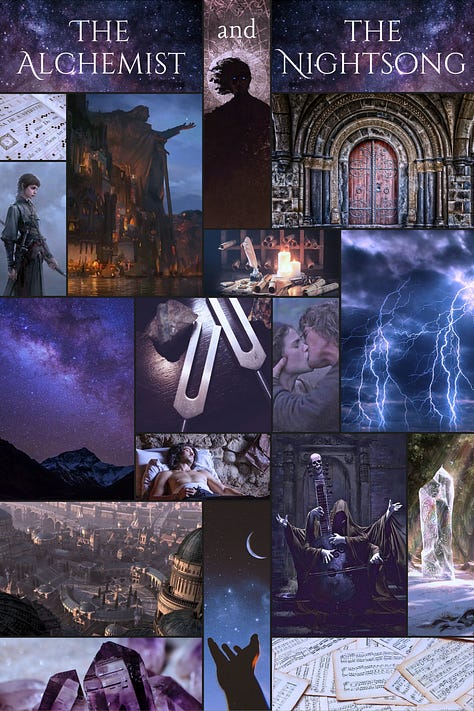
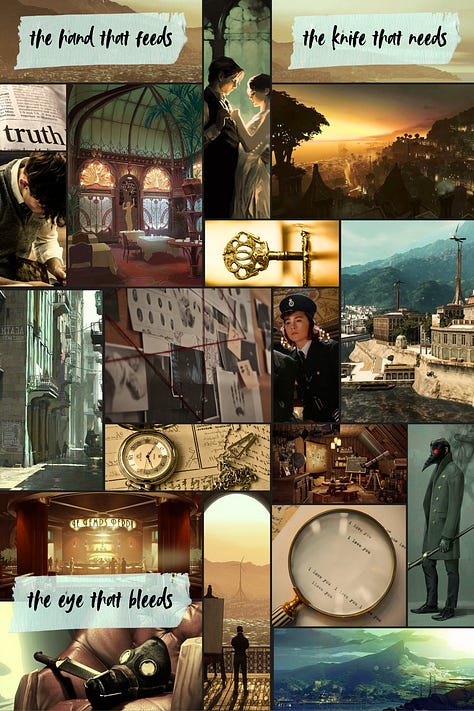
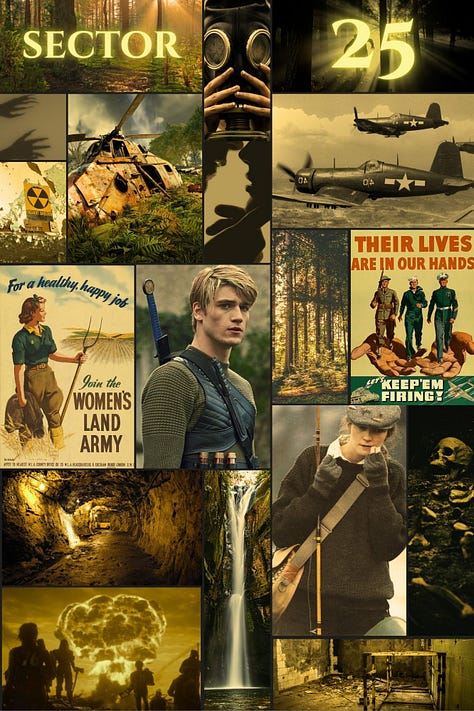
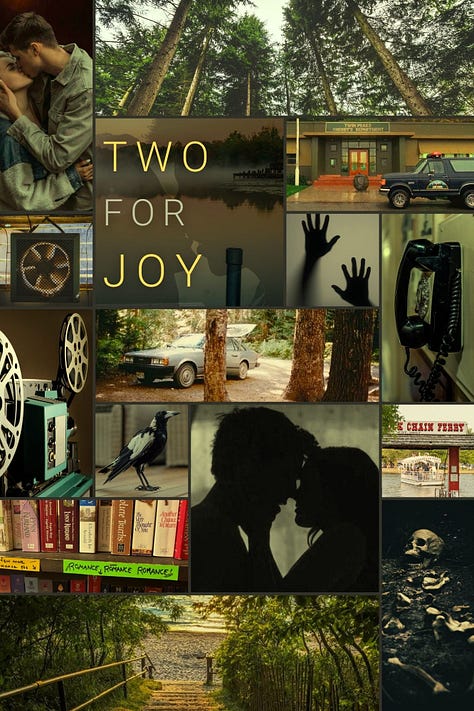
You can see we’ve got a pink spring scheme, a red-and-white winter scheme, a purple epic fantasy scheme, a sunset-and-turquoise mystery scheme, a sepia war/apocalypse scheme, and lastly a green-and-yellow summer scheme.
I have all of these moodboards in my Scrivener files, and sometimes—if I’m really wanting to make sure I nail the vibes and the voice—I’ll paste the moodboard directly into the notes feature on the Inspector panel. Then I constantly see the images and colors as I’m drafting.
A Note for the Non-Visual Creators
I realize not everyone uses visuals in the same way I do to create—and of course, some of you might be visually impaired. I get it! When my migraines are bad, I cannot look at screens or anything bright.
In fact, my migraines are why I turned to the Voice Dream Reader app after two of my friends (who are visually impaired themselves) recommended it.5
So on those days when I can’t rely on mixed-up fonts to help me out—specifically if I’m editing—I will instead let the robotic voices from Voice Dream Reader help me. You can use different accents, different styles, and that also helps me “click” into a new voice, world, and story.
Your turn! I’d love to know if YOU have any tricks for jumping between projects. Share them in the comments if you do—because I will 100% give them a try myself and see if they work for my brain.
Now, off I go to get edits on Two For Joy turned in before Friday as well as edits on one of my other projects that is a totally different genre and voice (😉). And oh yeah, I have so much promo to do for Witchlight.
I love being busy, though, especially when my personal/family life is (mostly) steady and calm.6 So I would not have it any other way.
💚 - Sooz
I had to download this one from Google Fonts because I just couldn’t capture the right vibe with any of the fonts pre-installed on my MacBook.
Okay, sometimes I might accidentally start typing a different main character name when I’m first easing in—if I’m working in third person, I mean. BUT I immediately catch myself, snort at my silliness, fix it, and proceed on.
Also, play BG3 and D:OS2. Incredible, incredible games.
This is kind of the only way I can endure my runs. No joke. I mentally transport myself into another world, and look at that! Somehow I’ve gone three miles without realizing it because I was so wrapped up in my character.
If you want better voices, you could also try Speechify, but they have shadier terms of service. I was advised not to use them if I want to safeguard my intellectual property.
Oh jeez, did I just curse myself?


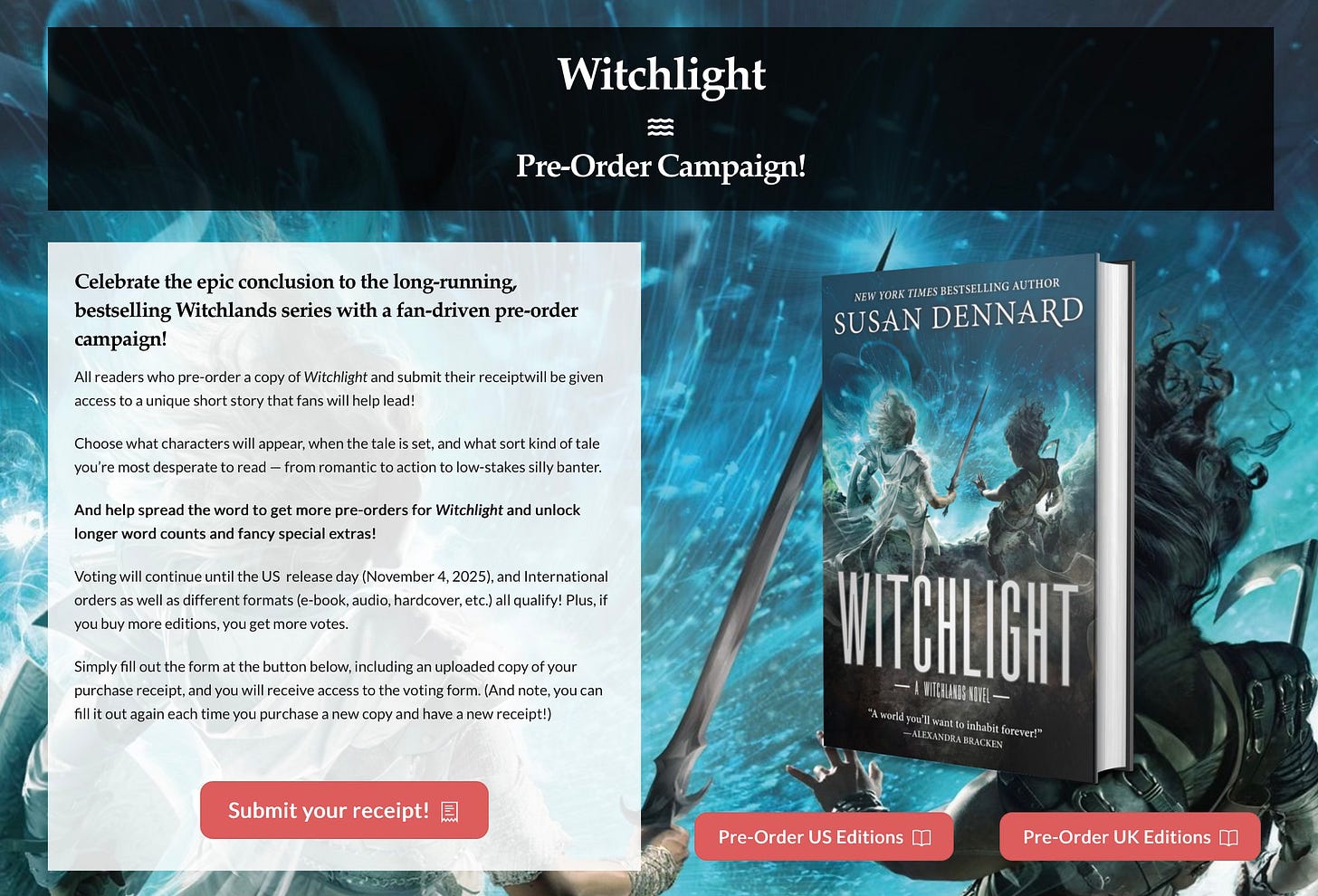
I hadn’t realized that I do this 😂 I wrote a contemporary fully in Helvetica and use serif for my fantasy drafts. I need to lean more into moodboards, as I think they would help me more. So cool to see yours!
Oooh, I'm going to have to try different fonts! I don't swap projects as aggressively as you do, but I tend to pass them off when I near the end of an act (I think this is an indicator that I don't properly plan my act breaks to coincide with character arc!) so if I'm doing a novella, that might be a week, and if it's an epic fantasy, probably about a month.
I also find it's important for me to write my scene screenplays in the right POV/voice. When I first started giving myself permission to swap between projects right away (instead of my usual approach where I'd be stuck on one thing for a couple of weeks then pick up the new and shiny fun thing), I went from a third person project to an EXISTING first person project, outlined the scene, drafted it, then about 3 hours later realised why drafting it had felt so weird. Yup, I drafted it in third and couldn't get my protagonist's voice right because *I had already drafted 30k words of her in first person*. I had this problem for a few days, then swapped to outlining the scene in first person in the character's voice, and that fixed it.
I do something similar to the playlists, but I often land on ONE piece of music for a book. When I was outlining the book I'm currently editing, I listened to a single 3ish-minute instrumental piece ON REPEAT for hours a day. When I got the book back from my editor guess what I listened to to get me back in the headspace?